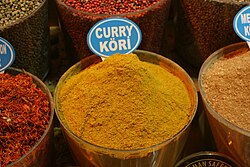Curry powder/ja: Difference between revisions
Tags: Mobile edit Mobile web edit |
|||
| Line 29: | Line 29: | ||
イギリスの貿易商は、19世紀中頃に[[:en:Meiji Restoration|明治]]時代の日本にこの粉を伝え、"[[Japanese curry/ja|日本のカレー]]"として知られるようになり、独特の料理へと発展した。 | イギリスの貿易商は、19世紀中頃に[[:en:Meiji Restoration|明治]]時代の日本にこの粉を伝え、"[[Japanese curry/ja|日本のカレー]]"として知られるようになり、独特の料理へと発展した。 | ||
==語源== | |||
= | 西洋において、"curry"という言葉は、様々なインド料理を広く指す言葉である。これらはインド亜大陸で異なるスパイスの組み合わせで調理されたものである。この"curry"というソース状の要素は、[[:en:Tamil language|タミル語]]で文字通り「[[Sauce/ja|ソース]]」または「[[Relish for rice/ja|飯]]のおかず」を意味する''kaṟi''に由来しており、インド亜大陸で数千年かけて進化してきた''jhol''、''shorba''、''kalia''といった地方料理を指す他の地域的な表現と同義である。 | ||
<div lang="en" dir="ltr" class="mw-content-ltr"> | <div lang="en" dir="ltr" class="mw-content-ltr"> | ||
Revision as of 19:48, 1 June 2025
| カレー粉 | |
|---|---|
 | |
| 種類 | カレー |
| 地域 | インド亜大陸 |
| 主な材料 | スパイス (コリアンダー, ターメリック, クミン, チリペッパー) |
カレー粉は、インド亜大陸発祥のカレー用のスパイスミックスであり、現地のスパイスミックスであるガラムマサラから派生したものであるが、それと混同してはならない。
歴史
西洋市場で商業的に入手可能なカレー粉は、伝統的なインドのスパイス混合物であるガラムマサラ('温かいスパイス'の意)に匹敵する。
インドのソースの風味を再現することを意図した既製の材料として考案され、最初にインドの商人がイギリスの貿易商に販売したものである。
カレー粉は18世紀のイギリスの料理本で材料として使用され、18世紀後半には市販されており、Crosse & BlackwellやSharwood'sなどのブランドは現在まで存続している。オーストラリアでは、一般的なカレースパイスはキーンズのカレー粉である。カレー粉という材料は、その製造方法の説明とともに、19世紀のアメリカやオーストラリアの料理本や広告にも見られる。
イギリスの貿易商は、19世紀中頃に明治時代の日本にこの粉を伝え、"日本のカレー"として知られるようになり、独特の料理へと発展した。
語源
西洋において、"curry"という言葉は、様々なインド料理を広く指す言葉である。これらはインド亜大陸で異なるスパイスの組み合わせで調理されたものである。この"curry"というソース状の要素は、タミル語で文字通り「ソース」または「飯のおかず」を意味するkaṟiに由来しており、インド亜大陸で数千年かけて進化してきたjhol、shorba、kaliaといった地方料理を指す他の地域的な表現と同義である。
Ingredients
A number of standards on curry powder have been defined. Most outline analytical requirements such as moisture, ash content, and oil content as well as permissible additives. Some also define a number of expected ingredients.
In the United States, curry powder is expected to contain at least these ingredients: turmeric, coriander, fenugreek, cinnamon, cumin, black pepper, ginger, and cardamom.
The 1999 East African Standard (EAS 98:1999) does not define an ingredient baseline. A newer 2017 draft from Uganda does require turmeric, coriander, cumin, fenugreek and mustard.
The Indian (FSSAI), Pakistani (PS:1741–1997), and international (ISO 2253:1999) standards do not define a baseline of essential ingredients.
Nutritional information
One tablespoon (6.3 g) of typical curry powder contains the following nutrients according to the USDA:
- Food energy: 84 kJ (20 kcal)
- Fat: 0.883 g
- Carbohydrates: 3.52 g
- Fibers: 3.35 g
- Protein: 0.9 g
| この記事は、クリエイティブ・コモンズ・表示・継承ライセンス3.0のもとで公表されたウィキペディアの項目Curry powder(30 April 2025, at 18:07編集記事参照)を翻訳して二次利用しています。 |